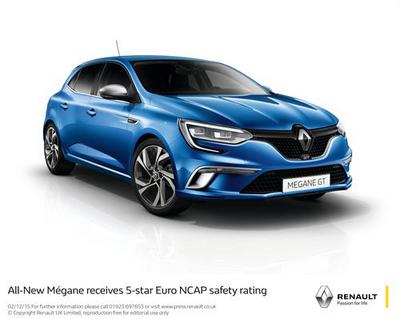All-New Renault Mégane Receives 5-star Euro NCAP Safety Rating
 All-new Mégane receives 5-star Euro NCAP safety rating |
- The new Renault Mégane has been awarded a five-star passive safety rating after testing by the independent body Euro NCAP
- The rating for the new Mégane takes the number of Renault models to have secured the maximum five-star rating in 2015 to four
- The new Renault Mégane features upgraded safety thanks to a suite of driver assistance systems which reassure and warn drivers for ease of driving
Benefits of the Common Module Family platform
MAPLE CROSS, UK -- December 8, 2015: When it comes to safety, the new Mégane shares the benefits of the same Common Module Family (CMF) platform as the Kadjar crossover. Features of this new platform include the use of very high elastic limit steel for the spars, side rails and cross members (notably those situated between the engine compartment and the cabin). A square millimetre of this type of steel can withstand a load of 120kg.
The CMF platform also incorporates effective occupant restraint systems, including dual-generator front airbags, the deployment of which adapts as a function of the type of impact and position of the occupant. This feature enabled the new Mégane to obtain high scores for both adult and child protection. Meanwhile, the seat belts are equipped with pretensioners and adaptive load limiters which adjust the degree of restraint to the severity of the impact and the occupants’ build. In side impacts, front occupants are doubly protected by two latest-generation side airbags and two curtain airbags.
A suite of driver aids
Thanks to the CMF platform, the new Mégane also benefits from the many driver assistance systems already featured on Renault vehicles from the segment above, such as the Espace. These aids are designed to reassure or warn drivers, or for ease of driving.
For reassurance:
- Adaptive Cruise Control automatically adjusts the car’s speed to maintain a safe distance to the vehicle ahead
- AEBS (Active Emergency Braking System) warns the driver to brake in order to avoid a head-on collision. The brakes are applied automatically in emergency situations
To warn drivers:
- Lane Departure Warning system warns drivers they are leaving their lane without indicating
- The Safe Distance Warning system helps the driver to maintain a safe distance to the vehicle ahead
- Overspeed Protection with Traffic Sign Recognition reads traffic signs in order to adjust the cruise control’s speed setting
- A Blind Spot Warning provides the driver with a visual warning when a vehicle is detected in one of the door mirror’s blind spots
For ease of driving:
- Switching from dipped to main beam head lights and vice-versa is automatic, requiring no driver intervention
- Driver aids also include Hands Free Parking (front, rear and lateral parking sensors) and a reversing camera, subject to specification
- A colour head-up display in the line of sight provides information about the majority of the driver assistance systems, the vehicle’s speed and navigation instructions
The Renault Talisman was also given a five-star rating at the same time as new Mégane, taking the number of Renault models to achieve the five-star rating in 2015 to four. The Kadjar and Espace, also benefiting from the CMF platform, were also awarded the rating by Euro NCAP earlier this year.
Anti-submarining: a Renault innovation dating back 15 years
For 15 years, Renault has innovated to prevent occupants from sliding beneath their seat belt in a head-on impact thanks to anti-submarining technology. To develop this technology, Renault uses specific crash test dummies equipped with more flexible groins to obtain simulations that are as close as possible to real-world situations. This technology calls for extensive work on seat ergonomics and on the positioning of the seat belt anchor points. In January 2015, the Euro NCAP protocol – which is made more severe every year – listed anti-submarining protection as a criteria for the first time.


